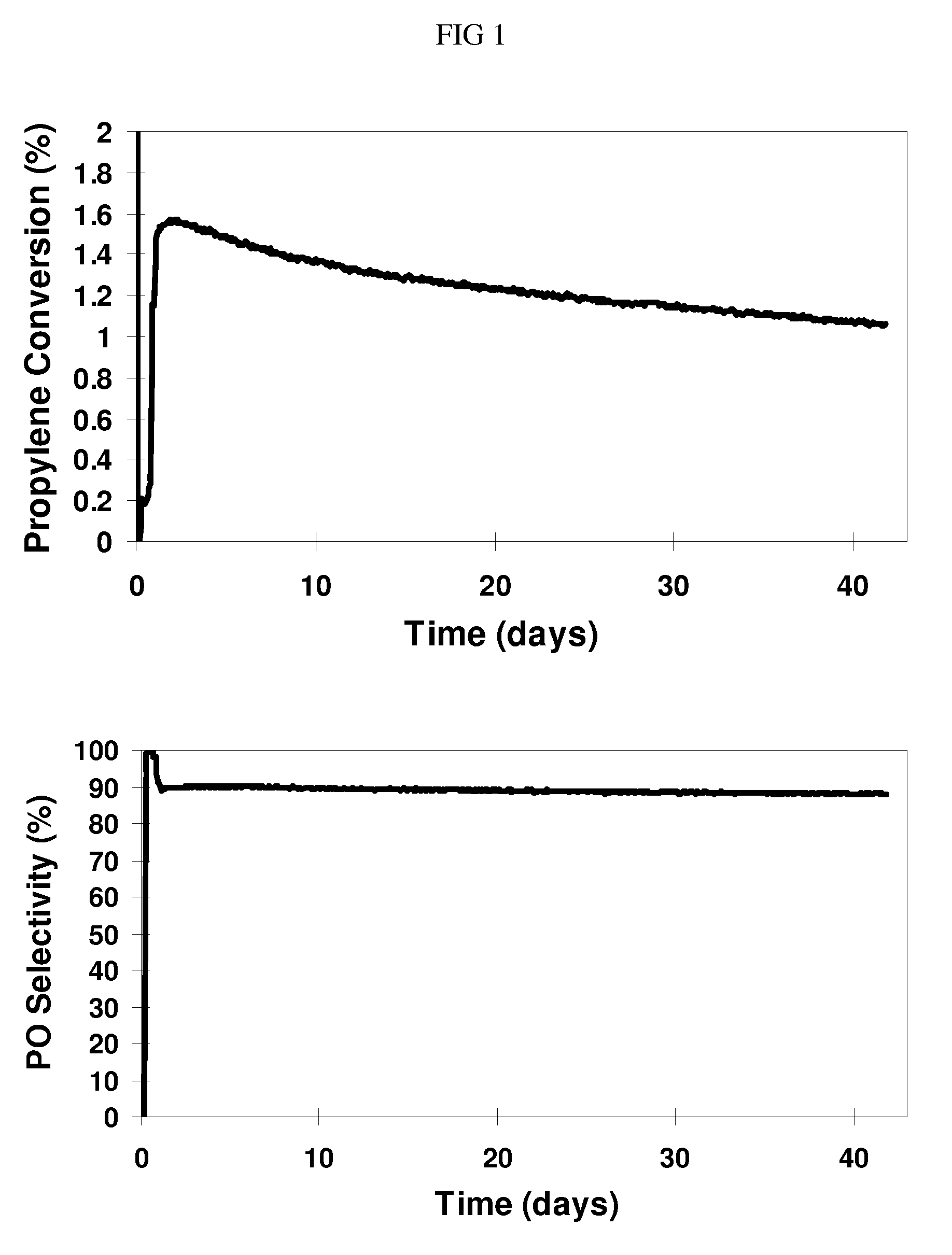Hydro-oxidation process using a catalyst prepared from a gold cluster complex
a technology of gold cluster complex and hydrooxidation process, which is applied in the direction of organic compound/hydride/coordination complex catalyst, physical/chemical process catalyst, bulk chemical production, etc., can solve the problem of unacceptably high cumulative unacceptably high water/olefin oxide molar ratio, and process produces significant quantities of partial oxidation. problem, to achieve the effect of increasing the interval, increasing the catalyst life, and stable catalyst activity
- Summary
- Abstract
- Description
- Claims
- Application Information
AI Technical Summary
Benefits of technology
Problems solved by technology
Method used
Image
Examples
example 1
[0142]A sample of the nanoporous titanosilicate support prepared as described hereinabove is oven dried at 110° C. for 1 hour. An aqueous sodium acetate (NaOAc) solution is prepared by mixing water (75 g) and NaOAc (0.737 g). The NaOAc solution (70.01 g) is added drop-wise into a flask containing the titanosilicate support (100.00 g), with shaking during the addition. The flask is transferred to a vacuum oven and is placed under vacuum at room temperature for 30 minutes, followed by two cycles of shaking and applying vacuum at room temperature for 30 minutes. The sample is then heated under vacuum to 70° C. (±5° C., 25 minute ramp time) and held for 1 hour. The heat is turned off, the sample is cooled to room temperature, and is maintained under vacuum overnight. The vacuum oven is purged with nitrogen and the sample is removed. The material is re-sized to 14 / 30 U.S. mesh (1410 / 595 μm) and is bottled.
[0143]A portion of the NaOAc-impregnated titanosilicate support is oven dried at 11...
example 2
[0148]A portion of the titanosilicate support, prepared as described hereinabove, is oven dried at 110° C. for 1 hour. An aqueous cesium acetate (CsOAc) solution is prepared by mixing water (4.979 g) and CsOAc (0.052 g). The CsOAc solution (1.54 g) is added drop-wise to the titanosilicate support (2.20 g). The sample is transferred to a vacuum oven and is heated under vacuum to 70° C. and held for 1 hour. The heat is turned off; the sample is allowed to cool to room temperature and maintained under vacuum overnight. The vacuum oven is then purged with nitrogen and the sample is removed and bottled.
[0149]A portion of the CsOAc-impregnated titanosilicate support is oven dried at 110° C. for 1 hour. A gold-ligand cluster solution is prepared by mixing Au9(PPh3)8(NO3)3 (0.0040 g) with acetone (2.873 g) and methanol (0.900 g). The resulting gold-ligand cluster solution (0.742 g) is added to the CsOAc / titanosilicate support (1.10 g). The sample is covered and held for 50 minutes. Then, th...
example 3
[0153]A portion of a CsOAc-impregnated titanosilicate support prepared as described in Example 2 is oven dried at 110° C. for 1 hour. A gold cluster solution is prepared by shaking Nanogold® brand Au-ligand cluster complex (30 nmol; 1.4 nm gold particles, Nanoprobes, Incorporated, Catalog no. 2010) with cold methanol (0.81 g). The solution is put into a freezer for 5 minutes, and then the entire volume of solution is added to the CsOAc / titanosilicate support (1.2 g). The sample is covered and held in a freezer for 1 hour. The sample is transferred to a vacuum oven, held at room temperature for 1 hour, heated to 105° C. over a period of about 30 minutes, held at 105° C. for 60 minutes, cooled to room temperature, and then maintained under vacuum overnight to yield a catalyst precursor composition of this invention. Elemental analysis: Au, 286 + / −5 ppm; Cs, 4380 + / −90 ppm; Ti, 4870 + / −90 ppm; Si, 42 + / −1 percent; and P, 15 + / −3 ppm. The catalyst precursor composition is then condition...
PUM
| Property | Measurement | Unit |
|---|---|---|
| particle size | aaaaa | aaaaa |
| particle size | aaaaa | aaaaa |
| particle size | aaaaa | aaaaa |
Abstract
Description
Claims
Application Information
 Login to View More
Login to View More - R&D
- Intellectual Property
- Life Sciences
- Materials
- Tech Scout
- Unparalleled Data Quality
- Higher Quality Content
- 60% Fewer Hallucinations
Browse by: Latest US Patents, China's latest patents, Technical Efficacy Thesaurus, Application Domain, Technology Topic, Popular Technical Reports.
© 2025 PatSnap. All rights reserved.Legal|Privacy policy|Modern Slavery Act Transparency Statement|Sitemap|About US| Contact US: help@patsnap.com



